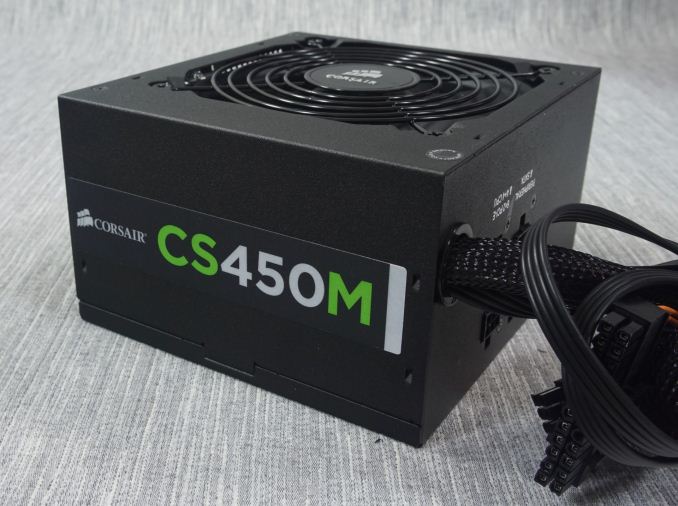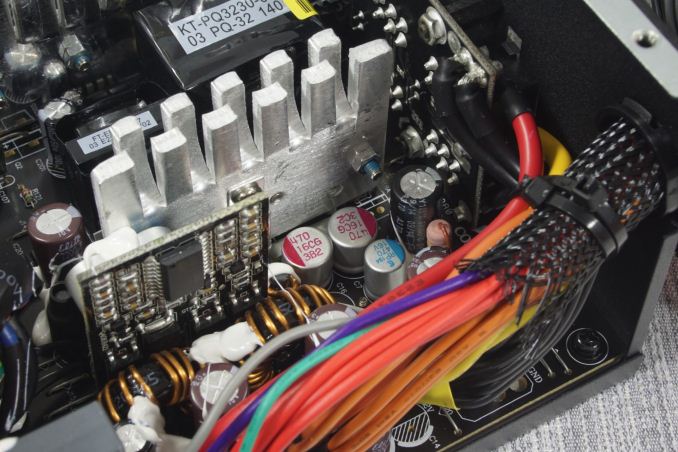The Corsair CS450M PSU Review
by E. Fylladitakis on June 10, 2015 8:00 AM EST- Posted in
- PSUs
- Corsair
- Cases/Cooling/PSUs
- 80Plus Gold
Conclusion
When assessing any kind of product, the first task is to determine the targeted audience. In the case of the CS -M series, it is obvious that Corsair is targeting those who are willing to pay a little extra over the cheapest solution possible for a good PSU, yet they still pursue the best bang for their buck. The 450W version that we reviewed today has an output ideal for typical home and office PCs, including medium power gaming systems with a single GPU, which covers a very large portion of the market. The retail price of $80 however is pushing the boundaries of cost effectiveness, as significantly more powerful PSUs can be bought for this kind of money.
Overall, Corsair managed to surprise us positively with both the performance and the quality of the CS450M. We did not expect a record-breaking product for that price, but the CS450M performed better than we anticipated. Due to the low power output and very good efficiency of the PSU, the losses are minimal and the necessity for cooling is relatively low. As such, the CS450M can function almost noiselessly under normal operating conditions. The power quality is good as well, as the CS450M suppresses the maximum voltage ripple on all lines at about 60% of the design limit when operating inside a hotbox and presents good voltage regulation figures. Indubitably, these performance figures are inferior to those we are used to seeing from top-tier units lately, yet the CS450M is not a product designed to compete against those in terms of raw performance.
However, what is even more surprising than the performance of the CS450M is the quality. When checking products of this range, we expect to find components coming from "low cost" (or even unknown) manufacturers. Instead, we found components inside the CS450M typically reserved for higher tier products. For example, all of the electrolytic capacitors that are critical for the long-term reliability of the PSU come from very reputable Japanese manufacturers. Even those of secondary importance are supplied by known manufacturers and are rated for operation at 105°C, a figure that it is next to impossible to be reached inside a 450W unit as efficient as this one. Great Wall did an excellent job making this PSU. It is not by chance that Corsair backs the CS450M with a three-year warranty.
There is only one issue regarding the CS450M. It has only a single 6+2 pin PCI Express connector, meaning that it cannot power many high-performance graphics cards currently available, generally topping out at GeForce GTX 960 or Radeon R9 270. In terms of power output, the CS450M should be able to cope with almost any single GPU card, as long as it is paired with a reasonable CPU and there is no serious overclocking/tweaking taking place. For example, a system with a typical four core CPU and a single GeForce GTX980/Radeon R9 280X GPU could be powered by the CS450M without issues. If someone however tries to power a system with the exotic AMD FX-9590 and a Radeon R9 295X2 with the CS450M, that would certainly not end well. Therefore, to reduce the risk of people making "unwise" hardware combinations despite the hardware specifications, Corsair decided not to provide two PCI Express connectors.
This move however will have everyone who wants to build a standard gaming PC, with just a single good CPU and GPU installed, thinking twice before buying a CS450M. This is especially true if someone is on a tight budget and is looking for used cards, as previous generation high performance models generally use two PCI Express connectors. This despite the fact that the power consumption of such a system with a single GPU should be below 400 Watts, well within the capacity of the CS450M.
With all of that said, there are solutions to the CS450M's limitations. 150-225W cards are increasingly using a single 8-pin connector instead of two 6-pin connectors (e.g. GeForce GTX 960/970). So this is likely a bigger problem in the present than the future, as the CS450M is able to drive those newer 8-pin designs. Meanwhile, adapters can be had to convert a couple of Molex connectors to a PCI Express connector for only a few dollars, with several manufacturers throwing in those adapters with their mid-range cards. Alternatively, one can split off the single 6+2 pin connector, though these are potentially risky as the current can surpass the threshold of a single PCI Express connector if used to drive a card designed for over 225W. In either case it is not impossible to build a very good gaming system powered by the CS450M, yet it pushes the user to either select a proper mid-range card or use an adaptor at the expense of two Molex connectors.
In summary, the Corsair CS450M is a very well made, reliable PSU that offers good overall performance, though without fancy bells and whistles. It has been designed to compete by offering high quality and good performance at a sensible price. However, the simple lack of two PCI Express connectors reduces the potential market of the CS450M, and requires owners of higher power graphics cards to either look into more specialized video cards, or pay a bit more for an adapter. Otherwise, for the out of the box experience, paying $80 for a PSU to power a sub-300 Watts PC is not a very cost-effective solution and is likely to drive the consumers towards lower cost models.
Meanwhile, the retail price of the CS450M is rather volatile, with the unit being on sale twice in the past couple of weeks alone and the retail price going as low as $57 including shipping. For such a price, the CS450M is a steal for users that want to power a home/office PC or do not mind the use of an adapter to power a performance graphics card. At its current retail price however, $80 is not the kind of fantastic deal that would make us to straightforwardly recommend purchasing the CS450M without some consideration.












46 Comments
View All Comments
Shadow7037932 - Thursday, June 11, 2015 - link
" Even those of secondary importance are supplied by known manufacturers and are rated for operation at 105°C, a figure that it is next to impossible to be reached inside a 450W unit as efficient as this one. "This isn't entirely accurate. The ambient temps around the caps especially the ones near the bridge rectifiers can be significantly higher than your average ambient temp of 25C. Sure, they won't really hit 105C ambient but temperature has a significant impact on the performance of electrolytic capacitors.
TurboTastic - Thursday, June 11, 2015 - link
I know there's already a huge number of comments saying this, but as someone who clamored for sane-wattage PSU reviews, I want to add my voice to the chorus saying "Thank you for listening to the readers and reviewing a <500W PSU!" I will definitely be considering this PSU in future builds - we need a new HTPC in the living room, and this might be a perfect fit!Seasonic's SSR-450RM is also in the running. It looks like it does have a few more cable options, including the 2x PCIe 8/6 pin power cables, but I'm not sure if it has the efficient rectification or quiet operation demonstrated in this review.
Seasonic - if someone is listening, thinks your product is better than Corsair's, and wants to make a (bunch of) sale(s), send an SSR-450RM to E. Fylladitakis!
Pissedoffyouth - Friday, June 12, 2015 - link
I love anandtech but PLEASE can you stop this graph crap. Start it at zero and end at 100, otherwise it makes the results seem different than they are.I expect more from this site.
ShieTar - Friday, June 12, 2015 - link
0 to 100 Watts? Degrees? Decibels? Efficiency? The graphs are perfectly fine as they are, why would anybody want to scale any single graph to 0 to 100 Units? Even on efficiency, scaling them to the proposed range would just make all graphs in all reviews look the same. Whats the point in that?FredAZ - Saturday, June 13, 2015 - link
When adding "age" to a word it means the rate at which something is attained. For Example "mileage" means the number of miles per gallon that a car attains. The term "watts" is the term for power, which already measures the flow of energy, or joules per second. Proper electrical terminology: power, current, Voltage, Energy, charge,wattage is redundant, please use "power", power already means the rate at which energy is being delivered, watts are the units
amperage is redundant, please use "current", current means the rate at which charge is being delivered, amperes (amps) are the units
voltage is proper because the correct term is elector-motive-force or emf, and no one understands this.
lagittaja - Sunday, June 14, 2015 - link
Great to see more reasonable power supply reviews from you.Now go and pester Super Flower, Seasonic and EVGA for review samples.
For example the Seasonic G-360, G-550. Super Flower Leadex or just EVGA's G2 lineup, the 550W G2 would be nice to see.